
|
|
The Sun-Earth ConnectionConceptsThe page describes how the Sun's energy is carried to Earth. The energy is carried by light waves (radiation) and by atoms, the tiny building blocks of matter. Here is a picture which shows the concepts that are important in understanding the Sun-Earth connection.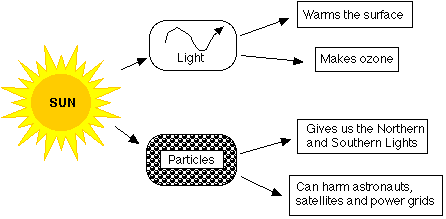 The light from the Sun heats the Earth's surface which makes the climate pleasant for life, in addition to making an ozone layer in the upper atmosphere to protect life from the Sun's harmful ultraviolet light. The atoms from the Sun carry energy which causes electricity to flow in the upper atmosphere. This electricity may alter the weather on the surface. The atoms can collide with spacecraft and are a potential hazard for astronauts. When these atoms hit the upper atmosphere they cause a spectacular light show you can see from the ground called the aurora. The SunThe Sun is the closest star to Earth and provides us with the energy necessary for life. Here is a picture of the Sun's lower atmosphere.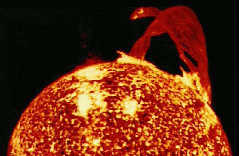 You can see from the picture the Sun is quite an active object, much like an erupting volcano. The loops of matter thrown from the surface, as seen in the picture, are the source for the atoms which eventually strike Earth. The visible part of the Sun which we see from Earth is called the photosphere. The photosphere is where the light from the Sun comes from. Although to us the Sun's surface appears smooth, it is actually grainy as seen in the following picture of the photosphere. The white places are called sunspots. 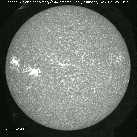 In the following movie, you can see the sunspots move as the Sun rotates. The Sun's photosphere is shown over an 8 month period, during which the Sun rotates about 8 times. To see the movie click here (MPEG movie; 1 Mb). The corona, the top layer of the Sun's atmosphere, normally can't be seen from Earth. The corona is where atoms leave the Sun for Earth. This stream of atoms is called the solar wind. The corona can be seen from Earth when the photosphere is blocked during a solar eclipse. Here is a picture of the corona during an eclipse. 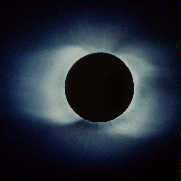 The solar wind blowing from the corona can be seen in the following movie. Please click here to see a MPEG movie of the the corona (1.1 Mb). How long does it take for the light and atoms from the Sun to reach Earth? It turns out that nothing moves faster than light, which moves so fast it can go around the Earth 8 times in only a second! The distance from the Sun to the Earth is 150,000,000 km. All light waves travel at a speed of 300,000 km/s. So, the time for light to reach Earth from the Sun is time = distance divided by speed = 8 and 1/2 minutesIf the Sun was to turn itself off right now we wouldn't know about it for another 8 and 1/2 minutes! Atoms go about the same distance to Earth as light, but move much slower, with a speed of 400 km/s. If this seems slow remember that the Space Shuttle goes around Earth at 8 km/s and a race car goes about 100 times slower than the Shuttle! We can figure out how long it takes for the atoms to reach Earth in the same way as for light: time = distance divided by speed = 4 and 1/4 daysLight from the Sun moves in a straight line to Earth, but the solar wind atoms move in a curved path due to the Sun's rotation. Imagine picking up a garden hose with the water running and swinging it around your head. I said imagine. Ask your parents before you try this!The water would not move in a straight line but in a curved (spiral) path. A picture of the spiral motion can be seen by clicking here. The Sun's Radiation and EarthThe following picture shows the three processes which move energy in the atmosphere.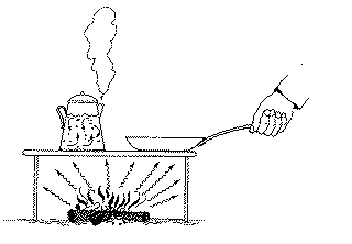 Figure from The Atmosphere by Lutgens and Tarbuck. The fire heats the cooking surface by radiation. In the same manner, radiation from the Sun heats the surface of the Earth. The frying pan heats up due to conduction. The atoms that make up the frying pan absorb the light energy and start to vibrate. By hitting into each other they move the energy throughout the whole pan. Some materials are better at conducting heat than others; that is why cooking pans are made of metal and not wood. A third type of energy transfer is shown in the picture. Notice the pot of boiling water. Have you ever watched water boil? As the water gets hotter, bubbles start to rise from the bottom of the pot. As the water begins to boil, the surface bubbles get more numerous and rolls form. This process is called convection. Earth's surface receives the radiation from the Sun and heats up. The heat is transferred to the air by conduction between the surface and the first few centimetres of air. Convection brings the heat up from the surface into the lower atmosphere. You have seen convection occur over your heads, but probably didn't realize it. Can you guess what common feature in the sky is associated with convection? Click here to find out! Puffy, fair-weather clouds (called cumulus clouds) occur in regions of rising air, while blue sky is in regions of falling air. This situation is just like the bubbles in a pot of boiling water, where the rising bubbles are like the clouds. The Solar Wind and EarthWe know there is electricity in thunderclouds (lightning) which can damage objects on the surface. The Space Shuttle is launched from Florida, where thunderstorms are common. The lightning can harm the electronic devices on the Shuttle.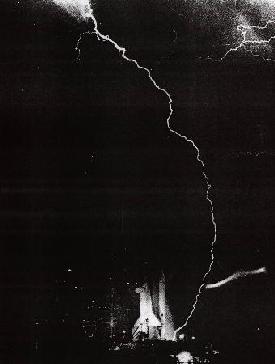 There is also electricity in the region of the atmosphere where the Shuttle flies, 300 km above the surface. This electricity is generated by the solar wind. The solar wind atoms can also smash into the atmosphere, causing the air to glow in different colours. This glow is called the aurora. 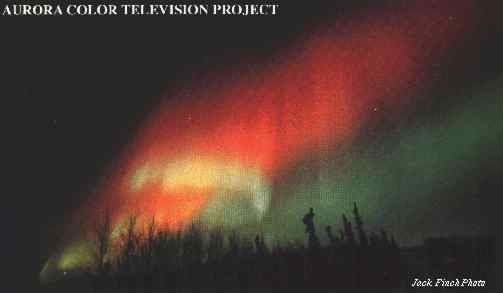 The aurora borealis (Northern Lights) and the aurora australis (Southern Lights), are usually green, but occasionally pink or red is visible. Auroras occur around both the North and South poles. Here is a picture of the aurora taken from space. 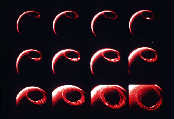 In the picture, Earth is the large dark ball, while the aurora is the bright ring of light. The aurora grows bigger and smaller like a jellyfish over just a few minutes, with the brightness of the light rising and falling. You can see aurora from London a few times a year, but the aurora is visible almost every clear night a bit farther north. Fort Churchill, Manitoba is an excellent location to see the aurora and was the site of many rocket launches to study the aurora. The motion of the aurora is spectacular. You can get an idea of these motions from the following video (courtesy of the Northern Lights Planetarium in Tromso, Norway). Click here to play a Quicktime movie of the the aurora (1.2 Mb). Thank you for reading this page. May I suggest you have a look at the first figure one more time to review the concepts of the Sun-Earth Connection. Questions or comments about this page? You can send e-mail to the author, Bob Sica, at the Department of Physics and Astronomy of The University of Western Ontario. Last updated: February 27, 1997 |